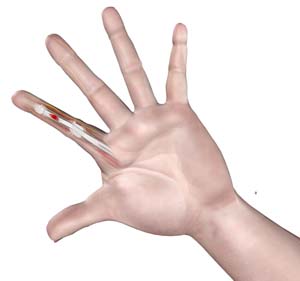Flexor Tendon Injuries

Anatomy of Hand Tendons
Tendons are bands of fibrous connective tissue that connect muscles to bone. Tendons aid in the movement of the fingers, hand and all other body parts.
There are two types of tendons present in the hand: the extensor tendons and flexor tendons. Extensor tendons present on top of the hand help straighten the fingers, while flexor tendons that lie on the palm side of the hand help in bending the fingers.
What are Flexor Tendon Injuries?
Deep cuts on the under surface of the wrist, hand or fingers can cut and injure the tendon, and make it unable to bend one or more joints in a finger. When a tendon gets cut, the cut ends gets pulled away from each other like a rubber band.
Flexor tendon tears may be partial or complete. If tendons are completely cut through, the finger joints cannot bend on their own.
Causes of Flexor Tendon Injuries
Any cut or laceration in the arm, hand or fingers can cause a flexor tendon injury. Other possible causes include:
- Damage to the tendon from a sports injury, often associated with football, rugby and wrestling
- Stretching of the tendon where the tendon is pulled off the bone
- Jersey finger: When a player’s finger catches on another player’s jersey or clothing
- Rheumatoid arthritis
- Adventurous activities such as rock climbing
Symptoms of Flexor Tendon Injuries
Inform your doctor if you have any of the following symptoms:
- Recent cut to hand or fingers
- Pain
- Swelling
- Loss of ability to bend the finger
- Numbness (loss of sensation)
First Aid for Flexor Tendon Injuries
Apply ice immediately to the injured finger. Wrap a sterile cloth or bandage around the injury and keep your finger elevated above your heart level to reduce bleeding if present. A tetanus injection may need to be administered.
Diagnosis of Flexor Tendon Injuries
Make sure to see a doctor when you sustain a finger injury that is affecting the flexion and extension of your fingers.
Your doctor will review your symptoms and medical history. A physical examination of both your hands will be performed. During the examination, you will be asked to bend and straighten your fingers. Your fingers will also be examined for sensation, blood flow and strength. An X-ray may be ordered to check for any damage to the surrounding bone.
Treatment for Flexor Tendon Injuries
A ruptured tendon cannot heal without surgery because the cut ends usually pull away after an injury.
There are many options to repair a cut tendon; the type of repair depends on the type of cut. The aim of the procedure is to restore the normal function of the joints and surrounding tissues following a tendon laceration.
Flexor tendon repair is usually an outpatient procedure and can be performed under local or general anesthesia. Your surgeon makes an incision on the skin over the injured tendon. The damaged ends of the tendon are brought together with sutures to achieve a secure repair. If the tendon injury is severe, a graft may be required. A graft is a piece of tendon that is derived from another part of your body such as a foot or toe. After the repositioning of the tendon, the incisions are closed with sutures and a dressing pad is placed over the surgical site. Your surgeon will place your hand in a protective splint to restrict movements.
Postoperative Care after Flexor Tendon Repair
Depending on the injury, you will be advised to start hand therapy for a few weeks following surgery. This is to improve the movement of the finger. Follow your surgeon’s specific instructions for a successful recovery.
Risks and Complications of Flexor Tendon Repair
The possible complications of flexor tendon repair include pain, bleeding, infection, stiffness, rupture of the repair, and damage to the surrounding nerves or blood vessels. A second surgery may be needed to release any excess scar tissue that interferes with finger movement.
Related Topics
- Pediatric Forearm Fracture
- Wrist Fracture
- Fractures of the Hand and Fingers
- Wrist Sprain
- Flexor Tendon Injuries
- Mallet Finger
- Finger Sprain
- Thumb Fracture
- Scaphoid Facture
- Finger Dislocation
- Adult Forearm Fractures
- Arthritis of the Hand and Wrist
- Forearm Fractures in Children
- Arthritis of the Thumb
- Ganglion Cyst
- Boutonniere Deformity
- Carpal Tunnel Syndrome
- De Quervain's Tendinosis
- Dupuytren's Contracture
- Trigger Finger
- Congenital Defects of the Hand and Wrist
- Hand Pain
- Hand Infections
- Wrist Injuries
- Wrist Tumors
- Gamekeeper's Thumb
- Hand Tumors
- Extensor Tendon Injuries
- Fingertip Injuries
- Wrist Ligament Tear and Instability
- Metacarpophalangeal Joint Arthritis
- Malunion of a Fracture

